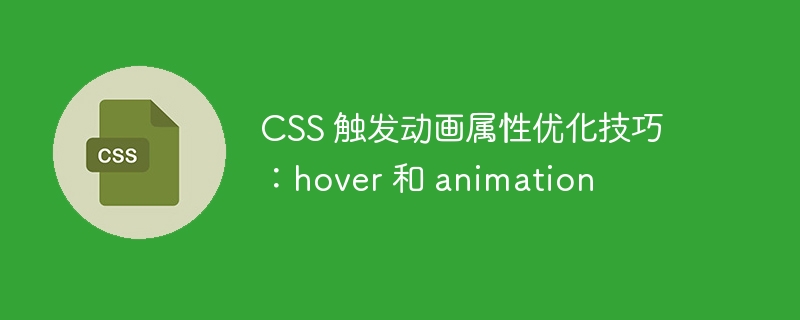

CSS trigger animation attribute optimization skills: hover and animation
Abstract:
In modern web design, animation effects have become one of the important means to improve user experience. one. The hover and animation properties of CSS are the keys to achieving animation effects. This article will introduce some optimization techniques for these two attributes and provide specific code examples to help developers better apply and optimize animation effects.
Introduction:
The hover and animation properties of CSS can achieve various animation effects in web pages. However, excessive or unreasonable use of these two properties may result in poor performance or less smooth animation effects. Therefore, it is necessary to master some optimization skills. This article will focus on the hover and animation attributes.
For example, we have a button, and we want the button color to change to red and have a fade-in and fade-out transition effect when the mouse is hovered. You can use the following sample code:
.button {
background-color: blue;
transition: background-color 0.3s ease-in-out;
}
.button:hover {
background-color: red;
}Use the transition attribute to smoothly transition the background color of the button, and you can adjust the transition time and transition effect to meet specific needs. This can provide a better user experience than directly modifying the background color.
Getting the style of an element and performing animation calculations are very performance-consuming operations. Therefore, excessive use of animation properties may cause animations to freeze or delay.
When using animation, you can consider the following optimization tips:
The following sample code shows a simple keyframe animation to achieve a rotation effect:
@keyframes rotation {
0% { transform: rotate(0deg); }
100% { transform: rotate(360deg); }
}
.rotate {
animation: rotation 1s linear infinite;
}By defining keyframe animation, the rotation effect can be achieved, and through the animation attribute and corresponding style properties to control. This provides greater flexibility and control in complex animation effects.
Conclusion:
The hover and animation properties of CSS are important means to achieve web page animation effects. By properly applying and optimizing these two attributes, the user experience of web pages can be improved. Optimization tips include using transition attributes to achieve hover effects, avoiding frequent use of frame-by-frame animation, and using keyframe animation to achieve complex effects.
We hope that the tips and code examples provided in this article can help developers better apply and optimize animation effects, thereby improving the interactive experience and performance of web pages.
The above is the detailed content of Optimization tips for CSS triggered animation properties: hover and animation. For more information, please follow other related articles on the PHP Chinese website!
 What language can vscode be written in?
What language can vscode be written in?
 What is the use of docker image?
What is the use of docker image?
 Problems with your wireless adapter or access point
Problems with your wireless adapter or access point
 Advantages of downloading the official website of Yiou Exchange App
Advantages of downloading the official website of Yiou Exchange App
 The difference between sqlserver and mysql
The difference between sqlserver and mysql
 What software is ig
What software is ig
 Introduction to the usage of vbs whole code
Introduction to the usage of vbs whole code
 Build an Internet server
Build an Internet server




